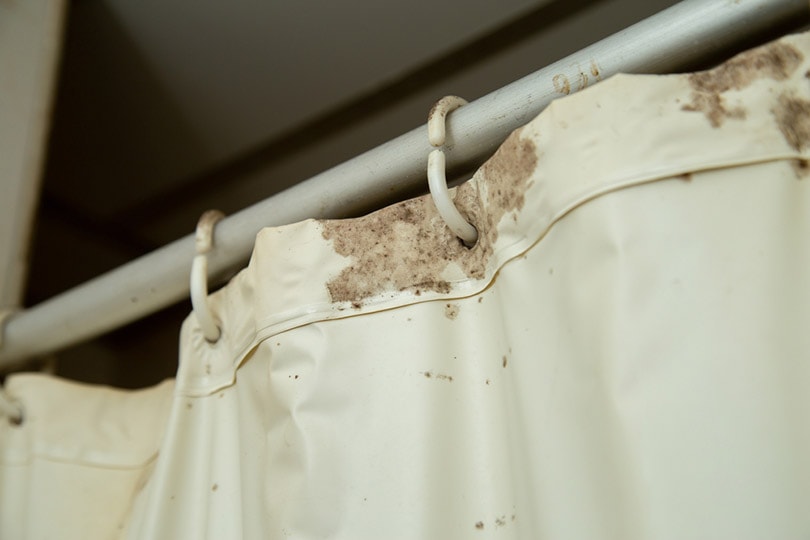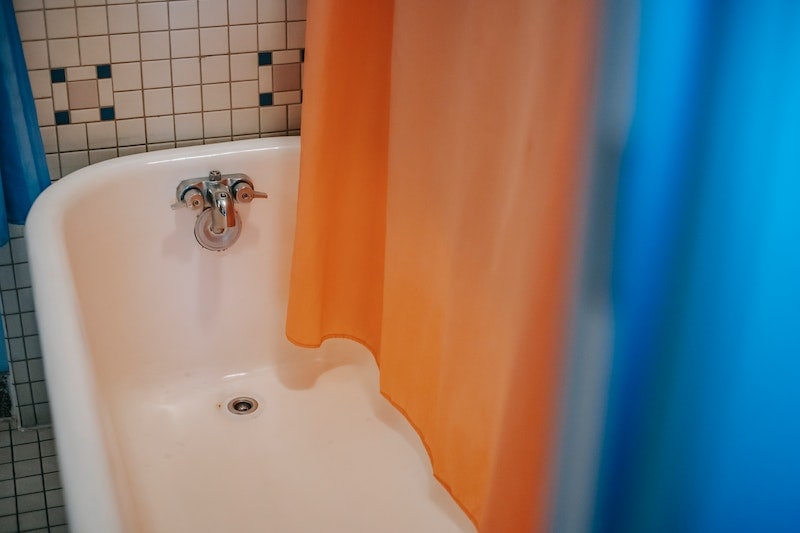How to Get Mold Out of a Shower Curtain: 3 Effective Steps
-
Visnja Radosavljevic
- Last updated:

A shower curtain is a practical way to have more privacy in your bathroom and keep water from splashing everywhere while showering. Still, since there’s always moisture, shower curtains can quickly become moldy, creating a big issue.
When this happens, most people want to throw away their shower curtain and buy a new one, but there’s no need to waste money since cleaning it is not complicated. We have a solution for all of you who struggle with moldy shower curtains but are unsure how to treat the stain properly.
Check out these three easy steps and learn how to clean your shower curtain like a pro.
The 3 Steps for Removing Mold From a Shower Curtain
1. Remove the Curtain from the Rod
Before cleaning, it might be best to remove the curtain from the rod. Of course, this is not something you have to do as you can clean the curtain while it’s still there, but the process will be much easier.
Since the curtains are moldy, put on rubber gloves to avoid direct contact with the mold.
2. Cleaning the Curtain
Once you have the curtain of the rod, it’s time for cleaning. You can try out different methods, depending on the ingredients you have at home.
All the cleaning options we will mention work well for plastic and fabric shower curtains, so you can try them all out to see which one works the best for you.
Baking Soda and Vinegar
You can treat the moldy stain with baking soda and vinegar. When doing this, you can make a solution that you’ll spray on the stains or add the ingredients into the washer and wash the curtain for better results.
If you decide to spray the stains, you’ll need to pour ½ teaspoon of baking soda, ½ a cup of vinegar, and ½ cup of lukewarm water into a spray bottle. After you finish, shake the bottle and spray the solution on the moldy stains, leaving it to soak for a couple of minutes. Once the stain soaks in the solution, take a dish sponge, gently rub the stains until the mold comes off, and clean the area with lukewarm water.
If you decide to wash the curtain, you’ll need to put it in the washer, set the temperature to warm, and the dial to be gentle. Add detergent as usual, and then add ½ cup of baking soda to the washer. You’ll need to pay attention to the cycles so that you can add ½ cup of vinegar once the process reaches rinse. When washing, it would be helpful to put a couple of towels inside to promote the cleaning action. Once the washer ends the cycle, take the shower curtain out and leave it to dry, preferably somewhere sunny.

Baking Soda and Hydrogen Peroxide
Another easy way to get rid of mildew on shower curtains is by making a mixture of baking soda and hydrogen peroxide. Hydrogen peroxide is a great disinfectant, while baking soda reaches deep into the stain to remove all mold particles.
Mix ½ cup of baking soda with hydrogen peroxide until you get an even paste. Once the mixture is ready, apply it to the moldy spots and leave it on for 15 minutes to dry out. Once dry, you can rub the area with lukewarm water and a dish sponge to clean the leftover paste or throw the shower curtain into the washer.
Lemon and Salt
Most of you have lemon and salt at home, and for all of you who didn’t know this, they make a great cleaning mixture that you can also use to get rid of mold from your shower curtains. Place the curtain in the bathtub, or lay it somewhere where it can be flat.
Squeeze out a lemon, and mix the juice with salt until you make a paste. Rub it into the stains and let it sit for 15–30 minutes. Once the time passes, wipe away the paste with a damp cloth. If needed, you can repeat this process multiple times until the moldy stains are no longer visible. For the best results, wash the shower curtain after this process and leave it to dry in the sun.

Oxygen Bleach
You can also try out the oxygen bleach treatment. For this solution, you’ll need to take your shower curtain and place it in the bathtub or take it outside if you have a shower that doesn’t have enough space to put the curtain down. Before treating the area, brush the curtain with a dish sponge to remove as much mold as possible.
Once you finish, pour hot water into the tub (if you have a small shower, try to find a container where you can place the shower curtain), add 4 tablespoons of oxygen bleach, and let the shower curtain soak for about an hour.
After that, press out the bleach-infused water, shake the shower curtain and rinse it with warm water. If possible, hang it to dry somewhere sunny, or attach it back to the rod to dry out.
3. Prevent Mold From Appearing Again
Once your shower curtain is free of mold, you should try to keep it that way and prevent mold from appearing again. If you practice prevention and clean the curtain regularly, mold won’t be an issue. We suggest cleaning the curtain at least once a month, although you can do it every two months if you cannot find the time for more frequent treatments.
- Air the bathroom out after showering
- Run the exhaust fan to reduce moisture
- Fix any leaks in the bathroom
- Clean shower/tub walls right after use
- Put a dehumidifier in the bathroom
What Causes Mold to Appear on Shower Curtains?
Mold can seriously affect your health and cause multiple health issues if not treated. It can grow anywhere, and your shower curtains represent a perfect spot for mold to spread.
It appears on shower curtains due to extreme exposure to moisture and humidity that remains in the bathroom after you shower. When bathing or showering, water splashes on the shower curtain and mildew can quickly occur when the water is left there without drying correctly.
That’s why it’s important to practice prevention and keep the bathroom as dry and clean as possible.
What Promotes Mold Growth?
Mold requires a temperature it can survive, water, food, and oxygen to grow. Once the environment checks all the boxes mold needs to grow; it can spread rapidly.
- Temperature: Each type of mold has a minimum, optimum, and maximum temperature range where it can grow. Most mold types cannot grow in colder temperatures, and they spread well in temperatures between 60°F and 80°F.
- Water: Moist will quickly thrive in humid, damp, and wet circumstances. It needs water to appear and spread, so your shower curtain represents the perfect spot for mold growth.
- Food: Mold needs materials it can digest, and since it can metabolize any natural matter, your fabric shower curtains will be very prone to it.
- Oxygen: Another thing mold needs to survive is oxygen, but it can grow even when the oxygen concentration is low.

Fabric vs Plastic Shower Curtains: Which is Better at Stopping Mold?
Both fabric and plastic curtains attract mold, although the creation of mold delays when using plastic shower curtains. While fabric shower curtains soak in the excess moisture from the air, plastic curtains repel the water and dry more quickly.
Shower curtains made of natural materials grow mold even faster than plastic ones, so although they have less aesthetic appeal, plastic shower curtains will be better at stopping mold.
Are There Mold-Resistant Shower Curtains?
For those who don’t want to deal with mold in the first place, there are mold-resistant shower curtains that will save you time and effort on cleaning. Those shower curtains are vinyl, polyester, polyethylene, or plastic. They won’t completely stop mold from growing, but they will certainly delay mold formation.
These curtains will be mold-free as long as you clean the curtain after every shower/bath you take.
Conclusion
If you have moldy shower curtains, there’s no need to throw them away. Instead, use one of the suggested cleaning solutions and efficiently remove the mold.
Since the best way to prevent it from occurring is to practice regular maintenance, ensure that you’re doing everything you can to delay and even stop mold growth on your shower curtains.
- See also: How Much Does Landscaping Cost
Featured Image Credit: sarapongwongpan, Shutterstock
Contents

